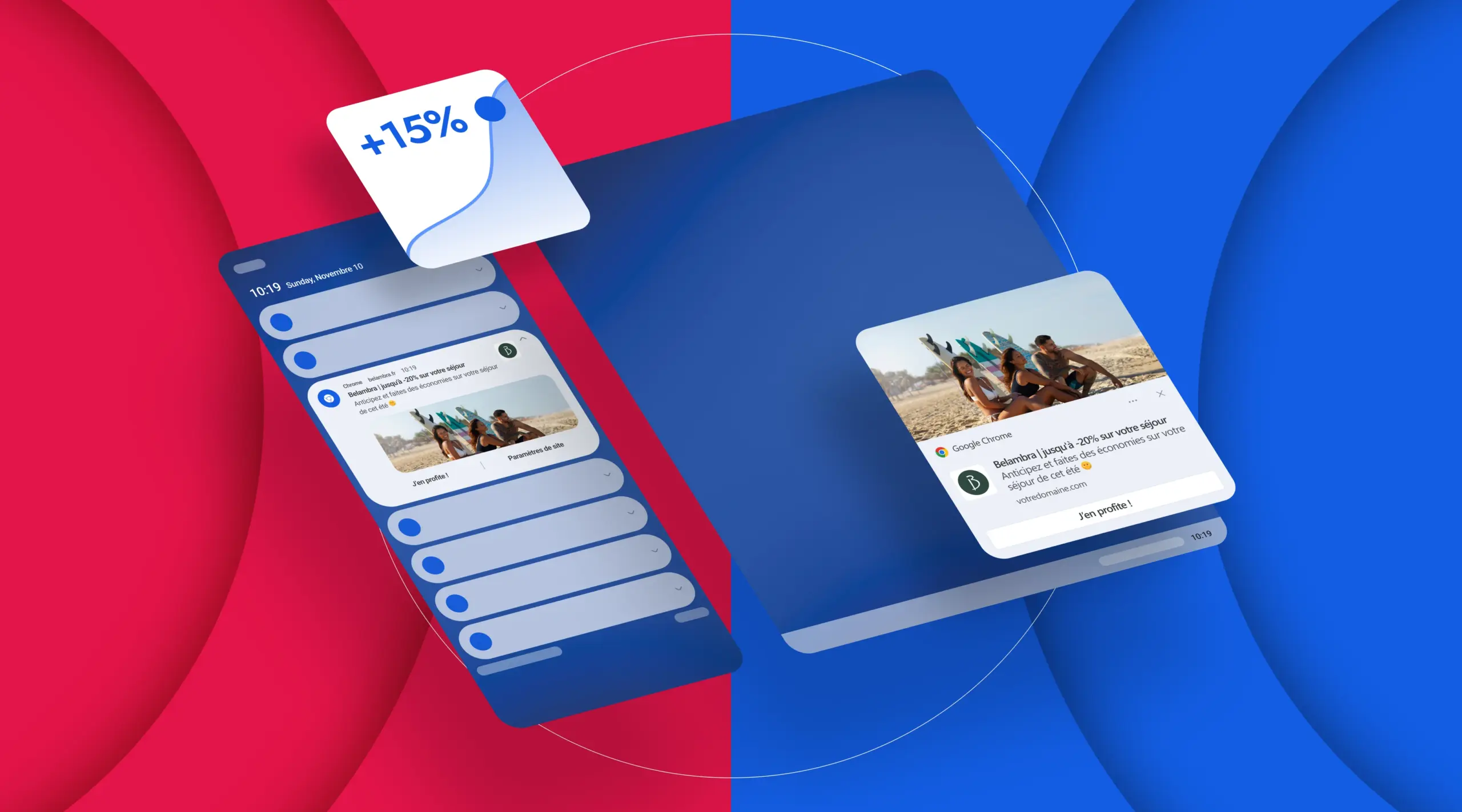
Placing ads on your website has become an essential method of generating online revenue. But how does this impact your traffic and your SEO? What best practices should you adopt to maintain a good user experience? This guide answers these questions in depth, while presenting modern, effective solutions like Adrenalead’s Web Push notification.
- Why advertise on your website?
- Advantages of Internet advertising
- What are the risks of advertising on your blog?
- Different methods for integrating advertising on your website
- Choosing the right advertising network
- Innovative alternative: Adrenalead's 360° advertising network
- Best practices for maximizing your advertising revenues
- Don't wait any longer to put ads on your site!
Why advertise on your website?
Putting advertising on your website is an essential strategy for generating passive income, without impacting the user experience (when well managed). Whether you’re publishing a media site or a blog, advertising allows you to monetize your audience by adding value to each visit.
Contrary to popular belief, you don’t need to have millions of visitors to your site: even modest traffic can generate profitability, via adapted formats.
What’s more, by diversifying your sources of advertising revenue, you reduce your financial dependence on other levers (subscriptions, direct sales, for example) while retaining control over your inventory.
Advantages of Internet advertising
Easy to set up
Setting up website ads is simple, especially with solutions like Google Adsense or other ad networks. Simply embed a code on your website and ads appear automatically.
Additional benefits
Advertising on your site is an excellent way for businesses to generate regular income, particularly to cover hosting and website maintenance costs.
Make the most of one-off visitors
Occasional visitors to your website become a source of revenue, even without a long-term commitment.
What are the risks of advertising on your blog?
Degradation of the user experience
Poor ad management can disrupt the user experience. Overloading a website with ads causes visual instability and slows down navigation, negatively impacting your natural search engine ranking.
Degradation of technical performance
Advertising agencies such as Google Adsense require external scripts, sometimes slowing down the loading of the website or blog, thus damaging your positioning in search engine results.
Loss of image and credibility
The presence of ads that are not relevant to your audience can damage your brand image, especially if they are poorly controlled by your advertising agency.
Irregular income
Advertising revenues fluctuate with the seasons and the advertising market, making your cash flow uncertain.
Different methods for integrating advertising on your website
Automatic advertising network
Ad networks like Google Ads or Adrenalead, for example, make it easy to place ads on your website without complex technical intervention.
Sell your advertising space directly
For greater control and higher revenues, selling your advertising space yourself can be an excellent solution. But it requires a real sales effort, of course.
Affiliate marketing
Affiliate marketing is an excellent alternative for monetizing your content by recommending products or services related to your niche.
Choosing the right advertising network
Selecting the right advertising network for your website is a key step in your monetization strategy. There are several important criteria to take into account, in order to ensure attractive revenues while preserving an optimal user experience and your natural referencing. Here are the main criteria to consider before making your choice:
Ad relevance and quality
Relevant advertising content is essential to preserve your website‘s image. The ads displayed must correspond to your theme and be of direct interest to your audience. Some ad networks, alternatives to Google Adsense, use intelligent algorithms to automatically display ads adapted to the profile of your visitors. Others, more specialized, give you more precise control over the type of advertising displayed.
Profitability and remuneration model
Not all ad networks are created equal when it comes to remuneration. Different models exist:
- CPC (Cost Per Click): remuneration for each click made on ads.
- CPM (Cost Per Thousand impressions): remuneration for each thousand ad displays.
- CPA (Cost Per Action): remuneration based on an action performed by the user (registration, purchase, download).
Depending on your audience and the nature of your content, some advertising networks are better suited to your profile than others. For example, Google Adsense performs particularly well in CPC and CPM, while affiliate networks such as Awin or Effinity excel in CPA.
Impact on technical website performance
A good advertising network should not significantly slow down your website. Some ad networks use heavy scripts that can significantly increase page load times, which can have a negative impact on your SEO and user experience. Opt for an advertising network with a reputation for optimized technical performance.
Level of control and integration
Depending on your need for control, choose a network that offers flexible integration and advanced campaign management options. For example, an advertising network like Ezoic enables you to carry out extensive A/B testing to identify the most profitable advertising spaces. A solution like Adrenalead makes it easy to personalize your advertising campaigns, while preserving browsing quality.
Privacy and RGPD compliance
The advertising network you choose must comply with current legislation on the protection of personal data (RGPD). Check that your advertising network complies with these legal obligations, particularly in terms of transparency vis-à-vis your users. Some advertising networks, such as Adrenalead, are particularly concerned about respecting personal data and present themselves as an innovative alternative that complies with RGPD requirements.
Technical support and customer service
In the event of technical problems or questions, the support offered by the advertising network plays a crucial role. Prefer an advertising network that offers responsive, available support, capable of helping you effectively when needed. Check other publishers’ reviews on forums or specialized sites to assess this essential aspect.
Reputation and user reviews
Finally, don’t hesitate to consult feedback from other bloggers or webmasters on specialized sites, discussion forums or social networks. These reviews will give you a concrete idea of the strengths and weaknesses of each advertising network, as well as the results achieved in terms of revenues and overall satisfaction.
Innovative alternative: Adrenalead’s 360° advertising network
Adrenalead offers complementary formats for on- and off-site monetization: Web Push Notification and display.
Adrenalead’s Web Push Notification stands out for its ability to effectively engage your visitors without any negative impact on website speed. Adrenalead enables precise targeting that respects user data, while being 100% RGPD compliant. For publishers already using Web Push with another service provider to push their editorial content, Adrenalead offers monetization of their audience, via this same format, while allowing them to keep the tool in place.
Their display solutions, alongside the classic IAB formats, also include In-page Push, an exclusive format.
Adrenalead’s connection to the market’s leading programmatic players means you can maximize your advertising revenues.
Best practices for maximizing your advertising revenues
Optimizing your website advertising revenues requires a strategic and methodical approach. Here are the best practices you can apply to get the most out of your ads, while ensuring an optimal user experience and good SEO performance.
Choose ad placement wisely
Ad placement has a direct impact on your click-through rate (CTR) and, consequently, on your revenues. Here's how to position them well:
- Above the waterline : place ads at the top of the page so that they are immediately visible, without scrolling. However, avoid taking up all visible space to preserve a good user experience.
- Close to popular content: integrate ads close to your most popular articles or sections, increasing visibility and the potential number of clicks.
- Between paragraphs of a blog post: ads placed between relevant paragraphs of an article often achieve very good results, provided they don't excessively interrupt reading.
Select the right ad formats
Choosing the right ad format is essential for maximizing revenue while minimizing user intrusion:
- Native ads : these ads blend seamlessly into your editorial content, reducing ad impressions while increasing their effectiveness.
- Standard graphic banners (728x90, 300x250): these classic formats are well accepted by users and generally perform well.
- Short video ads: integrated in moderation, they quickly capture attention and generate high revenue per impression.
- Web Push Notification: as this format is pushed to the surfer outside of their navigation on your site, it doesn't interfere with the reading of your articles and preserves the user experience.
Constantly test and analyze results
Use the analysis tools provided by your advertising network to precisely measure the performance of your ads. Solutions such as Google Analytics, Google Adsense or Adrenalead will provide you with detailed statistics on :
- Click-through rate (CTR): test different placements and formats to identify those that generate the best CTR.
- Revenues generated per ad: analyze which types of advertising bring in the most revenue and adjust your strategy accordingly.
- Bounce rate and average session length: monitor these indicators to ensure that your ads don't adversely affect the user experience.
Optimizing website speed and performance
A slow site can greatly reduce your advertising revenues, as it degrades both the user experience and your natural referencing. Here are a few technical best practices:
- Reduce the number of external scripts: limit your ad networks to those whose scripts are optimized for speed, such as Adrenalead or Google Adsense.
- Use an efficient cache and CDN: this allows ads and content to load faster, improving your SEO performance and visitor satisfaction.
- Regularly monitor your technical performance: use tools such as Google PageSpeed Insights or GTmetrix to constantly optimize loading speed.
Check ad relevance and quality
Make sure your ads are relevant to your audience to preserve your credibility:
- Filter out irrelevant categories: remove ads that aren't relevant to your audience via your ad network's management interface.
- Offer regular polls or surveys: gather feedback from your visitors, so you can tailor ad delivery to their actual preferences.
Be transparent with your visitors
Trust is an essential lever for maximizing long-term revenue:
- Clearly state how ads are used: inform your users that you monetize your site through advertising, in particular through a visible and accessible privacy policy.
- Avoid deceptive techniques: never hide ads behind download buttons or article links. These practices damage your reputation and ultimately reduce click-throughs.
Diversify your sources of advertising revenue
Don't depend solely on one advertising network or one type of advertising:
- Combine several methods: mix affiliation, display advertising and Web Push Notifications to create stable, diversified revenues.
- Integrate native advertising and affiliation: use sponsored content , product comparisons and honest recommendations to increase your monetization potential.
By following these best practices, you'll optimize your advertising revenues while offering an excellent user experience - the key to a sustainable, high-performance monetization strategy.
Don't wait any longer to put ads on your site!
Putting advertising on your website is a wise move if it's well executed. Choose your advertising network carefully, diversify your advertising formats and consider adopting innovative, user-friendly solutions like Adrenalead's Web Push Notifications, for successful, sustainable monetization.



